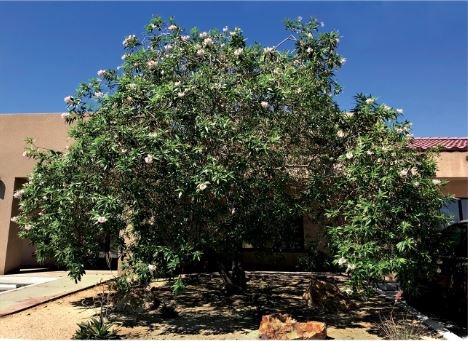
Plant Form: Tree
Water Use: Low, Moderate
Mature Size: 15 – 25 ft. tall x 15 – 30 ft. wide
Exposure: Full sun, part sun
Bloom Time: Spring (March – May), Summer (June – August), Fall (September – November)
Hardiness: Cold Hardy to -20°F
Native to: Hybrid from U.S. parents
Chitalpa inherited some of the best qualities from each of its parents, producing an exciting, drought-resistant plant ideally suited for most soils and climates in the American southwest. This hybrid deciduous tree is a cross between Desert Willow (Chilopsis linearis) from our southwest desert washes, and Southern Catalpa (Catalpa bignonioides) from the southeast U.S., combining the drought tolerance of Desert Willow with the cold tolerance of Southern Catalpa. Chitalpa has larger flowers and more lush foliage than Desert Willow, but this sterile hybrid doesn’t produce long, narrow seedpods like its parents, creating less litter than either parent. Its bloom season is incredibly long. Bright-green leaves showcase abundant, trumpet-shaped, lavender-pink flowers in upright clusters of 15-40 flowers, which hummingbirds love. Use as a specimen tree, shade tree, accent, screen, patio plant (deep taproots won’t lift cement), or in dry washes and hummingbird gardens.
THIS MONTH IN YOUR DESERT-SMART LANDSCAPE
Smart water-wise practices pay off now: climate-adapted plants + mulch + deep watering = less water use.
- Check irrigation emitters, valves, and lines for clogs, leaks, and brakes.
- Flush out lines by removing end caps with your water system on; sand or deposit that build up in lines can clog emitters.
- Leave a dripping hose at the drip-line of trees and shrubs to deeply soak soil once a month; set a timer to remind you to move hose to next plant.
- Keep adding to mulches as they decompose to conserve water, keep roots cool, and reduce frequency of watering.
- Encourage repeat blooming by pinching or cutting back annuals, perennials, and shrubs.